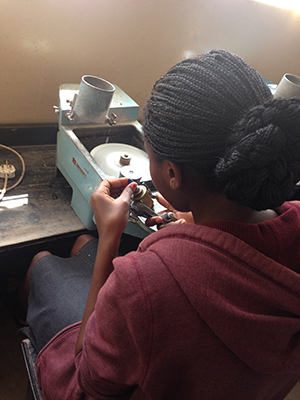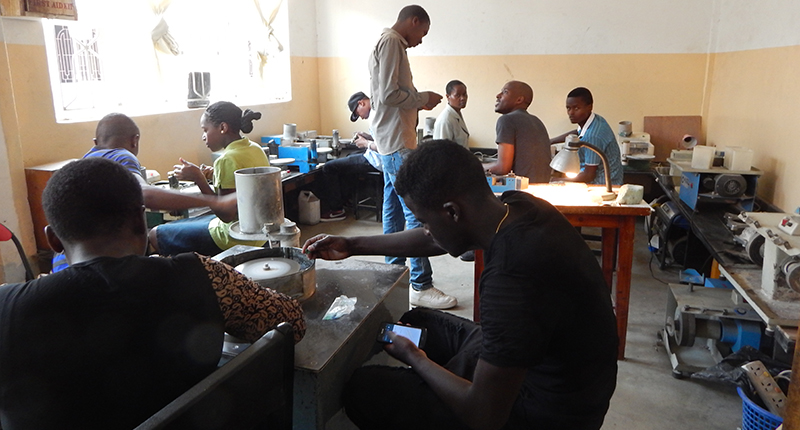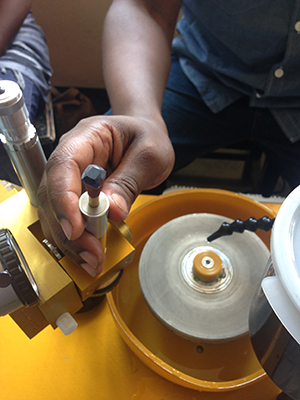“Bridgerton” actresses Hannah Dodd and Claudia Jessie star in the brand’s “Rules to Love By” campaign.
T.I.A., Part 3: East Africa’s Changing Gemstone Market
As Tanzania and Kenya move to have the export of all rough banned, both will need to focus on growing their cutting industries. Associate Editor Brecken Branstrator talks to a few people who are playing a part in that.


Both Tanzania and Kenya have made announcements that within the next few years (they’re aiming for 2018), both will ban the export of gem-quality rough. Rather, the gemstones will be cut before leaving the country in an effort to add value to the stones and boost the economy.
This is only one part of the change and development that many are trying to bring to the gemstone market in East Africa, but since it also played a part in our trip, I want to focus on this for now.
It’ll be interesting to see if both Tanzania and Kenya are able to meet the deadlines they’ve set for themselves.
Tanzania already has a law in place that no tanzanite rough larger than 1 gram (5 carats) can be exported from the country, so the country’s infrastructure is more equipped to handle such a change over a period of a few years--Tanzania has roughly 600 gem cutters, as well as a number of lapidary schools already established.
We visited one of these while we were there--the Arusha Gemmological & Jewelry Vocational Training Centre. It’s a small, independent vocational school run by Peter Salla, who was once a full-time trainer for TanzaniteOne. The school has graduated more than 800 students since its founding in 2000, nearly a third of which are women. While many of them pay tuition, Peter also looks for scholarship candidates, many times finding students who have come from very humble and difficult beginnings and wouldn’t have had the opportunity for such learning otherwise.
The center has two rooms, one of which is used as a classroom to teach students about grading and evaluating gems, and the other is set up for hands-on faceting work. When we went into the school, a handful of students were at work, dopping the stones with wax to the machines and practicing cutting marbles on various machines.

It’s clear that Peter works very hard to bring this skilled training to his students and is doing the kind of work that is needed if East Africa’s gemstone trade is going to grow and develop.
Kenya’s a little further behind its neighbor in establishing its cutting sector.
Roger told me that he estimates the country has somewhere in the range of 50 to 75 cutters. There also aren’t any lapidary schools operating yet, though the Kenyan government said last summer that it was investing some 30 million shillings (about $293,000) to set up a gemstone cutting center in Voi meant to create employment as well as adding value to the country’s stones.
While I was in East Africa, I also learned about a project that gemstone dealer and broker Gichuchu Okeno and Roger are establishing, along with jewelry blogger Monica Stephenson of iDazzle--a private lapidary center in Kenya designed to help provide training for the people there.

During our drive from the airport to the hotel on the first night we landed at Mt. Kilimanjaro, I had the chance to talk to Okeno about the challenges he’s seeing in the market and what he wants for the future. What continued to strike me about him then, and throughout the trip, was his sincerity in wanting to help others--not only wanting to elevate the gemstone market in East Africa into something sustainable, respected and valued for its quality stones but also wanting to create something that can provide opportunity for the population.
Roger and Monica obviously share the same hopes as they help build the gem community in a way that allows the people involved to flourish and then contribute on their own. This center will definitely play a part in that, and though the conversation about the center was years in the making before the country made its intentions known, it is well-timed to take part in the movement.
It tentatively will be called the Voi Lapidary Centre, but that could change if they decide to add more skills than just gem cutting, Roger told me. Rather than being designed to be a profit center, the school will be meant to help train young people, who, after graduation, will be encouraged to either seek employment by firms or to take in their own work from various mining operations.
The skilled training that it, and places like Peter Salla’s school, offer will be necessary for East Africa’s gem trade to develop, and I’m happy to have met a few of the players who will have a hand in that.
The Latest

Founded by jeweler and sculptor Ana Khouri, the brand is “expanding the boundaries of what high jewelry can be.”

The jewelry manufacturer and supplier is going with a fiery shade it says symbolizes power and transformation.

How Jewelers of America’s 20 Under 40 are leading to ensure a brighter future for the jewelry industry.

The singer-songwriter will make her debut as the French luxury brand’s new ambassador in a campaign for its “Coco Crush” jewelry line.


The nonprofit’s new president and CEO, Annie Doresca, also began her role this month.

As the shopping mall model evolves and online retail grows, Smith shares his predictions for the future of physical stores.

Roseco’s 704-page catalog showcases new lab-grown diamonds, findings, tools & more—available in print or interactive digital editions.

The trade show is slated for Jan. 31-Feb. 2 at The Lighthouse in New York City's Chelsea neighborhood.

January’s birthstone comes in a rainbow of colors, from the traditional red to orange, purple, and green.

The annual report highlights how it supported communities in areas where natural diamonds are mined, crafted, and sold.

Footage of a fight breaking out in the NYC Diamond District was viewed millions of times on Instagram and Facebook.

The supplier has a curated list of must-have tools for jewelers doing in-house custom work this year.

The Signet Jewelers-owned store, which turned 100 last year, calls its new concept stores “The Edit.”

Linda Coutu is rejoining the precious metals provider as its director of sales.

The governing board welcomed two new members, Claire Scragg and Susan Eisen.

Sparkle with festive diamond jewelry as we celebrate the beginning of 2026.

The master jeweler, Olympian, former senator, and Korean War veteran founded the brand Nighthorse Jewelry.

In its annual report, Pinterest noted an increase in searches for brooches, heirloom jewelry, and ‘80s luxury.

Executive Chairman Richard Baker will take over the role as rumors swirl that a bankruptcy filing is imminent for the troubled retailer.

Mohr had just retired in June after more than two decades as Couture’s retailer liaison.

Shekhar Shah of Real Gems Inc. will serve as president of the Indian Diamond & Colorstone Association in 2026.

This year’s good luck charm features the mythical horse Pegasus, and is our first Piece of the Week of the new year.

As part of the leadership transition, Sherry Smith will take on the role of vice president of coaching strategy and development.

It marks the third time the country has headed the Kimberley Process. Ghana will serve as vice chair.

The new Bulova x Stetson designs highlight two animals often associated with the American West—the bison and the Texas Longhorn.

Its residency at Yamron Jewelers will run through May 2026.



























